Feature Interview with Paul Jansen
April, 2020
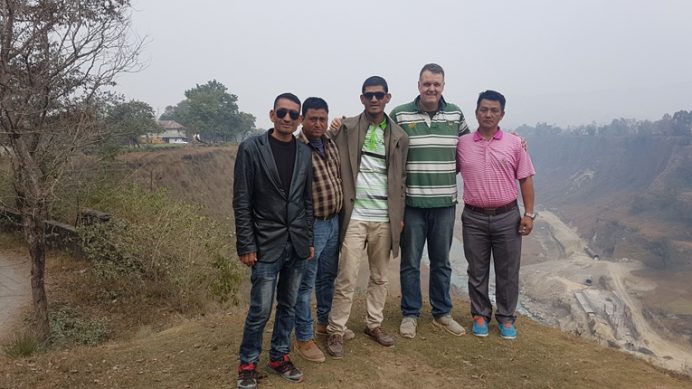
Paul Jansen at Himalayan GC with Nepalese colleagues.
1. To my knowledge, you are the only person we have interviewed that was born in Zimbabwe and raised in South Africa! How did such an upbringing shape your sensibilities in golf course architecture?
We left Zimbabwe when I was very young and settled in Durban, South Africa where I took up the game. My father, who was born and grew up in Zimbabwe, would tell me stories about playing at places like Royal Harare GC, Chapman GC or even in Bulawayo but other than that, I had no knowledge of golf north of the border growing up. The last time I visited Zimbabwe was in 1987 but I did visit a few golf courses relatively close by in Zambia last year and this has motivated me to head back to Zimbabwe for reasons other than golf.
I started playing at Royal Durban GC (not to be confused with the more renowned Durban CC) when I was 11. The course was unique in that it was situated in the middle of a horse racetrack, which came into play on a number of holes, and there was also a main road that ran through the centre of the course. Playing golf repeatedly at RDGC effected on my sensibilities in that it showed me that unconventional features actually add interest rather than take away from the sport. That is something that I embrace in my own work today.
RDGC had reciprocal agreements with a high percentage of golf courses across the land which afforded me the opportunity to play golf in a lot of different environments throughout South Africa which eventually sparked my interest in design.
South Africa has a few dozen golf courses designed by renowned course architects like Col S.V Hotchkin, C.H Allison, Fred Hawtree and Bob Grimsdell, most of which I’ve been fortunate to visit but I am still most fond of Durban CC by Laurie Waters from a design perspective. I was always enthused by some of the wonderful ground movement and naturalness at Durban CC and its other course Beachwood a few miles up the road.
Having said that, the unique offerings that have probably shaped my mindset the most are the Gary Player CC at the Sun City Resort and other “bushveld” golf courses including some modern takes like Kabaku Komatipoort, Elements, Zebula and Skukuza. These courses are uniquely African, all have strong sense of place and emphasize the natural environment and overall experience.

Zebula is an example of bushveld golf that enjoys a strong sense of place.
2. After university, you were based in London for 8 years, then Switzerland for 3 years and now Canada for 6 years yet have never worked in the place that you lived! You have been to approximately 60 (!) countries so how is it that you have come primarily to work in undeveloped or developing regions like Turkey, Vietnam, Thailand, Bangladesh and Romania?
I would like to have stayed in South Africa but if I knew that if I wanted to get into this profession, I needed to work abroad to progress my education. Therefore, when I completed my studies in Johannesburg, I left for the U.S.A. to do an internship with course Architect Thomas E Clarke of Ault, Clarke and Associates, who happens to have been your last month’s Feature Interviewee. Talk about a small world! Anyway, I was based outside of Washington D.C. for nearly a year and toured courses with Tom around the D.C. area for the majority of my stay.
After my time in the States, I went to the United Kingdom at the end of 2000. I was lucky to hold a British Passport and toured as many links and heathland courses as I could, plus I explored Europe. I needed to find employment relatively quickly and ideally in course design. When I started with Nick Faldo in London, ALL the work was outside of the United Kingdom in places like Portugal, Turkey, Ireland, Italy and Denmark. After the 2009 market correction, the majority of the work shifted to Asia and the developing world. I continued to work with Nick even when I was based in Switzerland.
3. How did you come to work for Nick Faldo Design?
When I moved to the United Kingdom, I didn’t get back into course design straight away. There were limited opportunities at the time and I needed to find work quickly as I was running out of money. I was fortunate however, I had studied Geographic Information Systems (GIS) as part of my degree, and was able to get work in this field. GIS was a relatively new phenomenon at the time (today just about everyone uses some form of GIS) and there was demand for people with any experience so I contracted for the railways helping them build some of their early intelligent mapping systems. It paid well, which afforded me the opportunity, in my spare time, to travel throughout the UK and Europe in search of great golf which I did frequently from 2001 – 2004. I also started to purchase as many books on Golf Course Architecture as I could find. So whilst I was not working in course design, I was still educating myself.
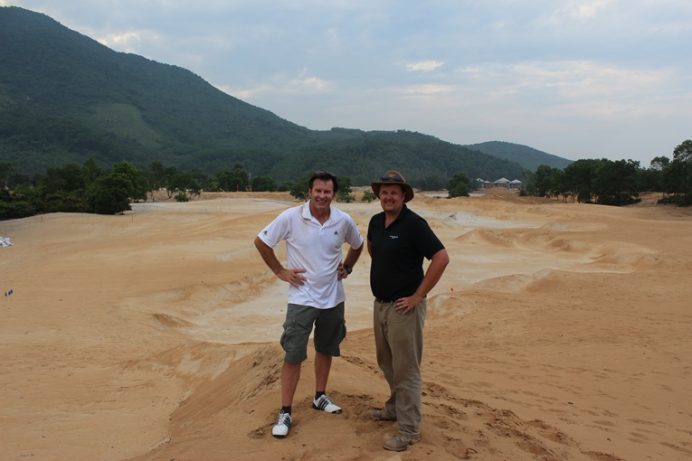
Sir Nick Faldo and Paul Jansen at Laguna Lang Co.
Then roughly two and half years later whilst visiting my girlfriend in Poland I got a call from a contact asking if I would be interested to get back into course design. I interviewed with the Faldo team and a few weeks later on holiday in Italy was offered the position. I started at the end of 2004.
4. Which were some of your favorite projects for him?
Ironically, some of the projects that never got completed, specifically Ponta Do Pargo on the island of Madeira and La Repose in South Africa between the cities of Port Elizabeth and East London. Those were magnificent sites and the teams were fantastic. The golf course at Ponta Do Pargo was at the western tip of Madeira and we routed 8 of the holes along the cliff edge with 200m+ drop to the ocean.

Pic of Ponta Do Pargo, Madiera
The La Repose site was situated in and alongside some of the biggest sand dunes in the Southern Hemisphere.
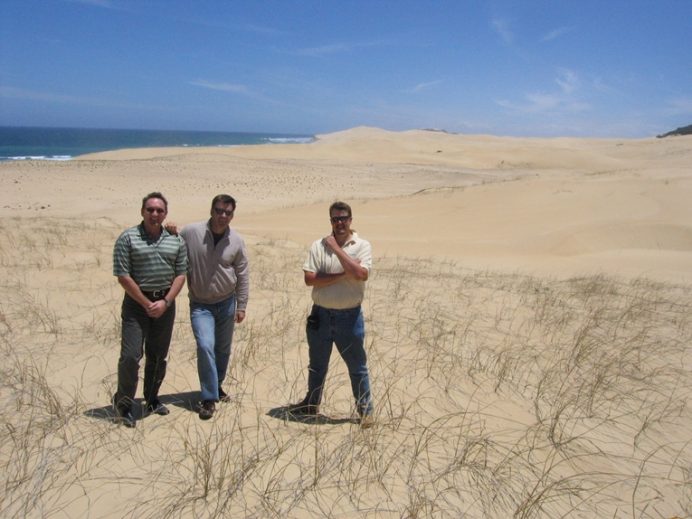
La Respose, South Africa
5. That’s awful – the photographs are magnificent! What happened to those projects? Does the opportunity exist today to build on those sites?
I’m a glass half full kind of a guy, so you have to think one day maybe there will be a golf course in these locations but there is so much unpredictability in both golf development and the world today.
I spoke with friend Stuart Mclean – who was the previous editor of Southern African Golf Digest and also penned the wonderful book South Africa’s greatest golf destinations – about the La Repose project not too long ago. Stuart was involved in the project back in 2006 and he did not speak as if there was a chance it would restart anytime soon.
Regarding Ponta Do Pargo, I remain in contact with a few of the people on the island who were involved when we were full steam ahead and they recently informed me that the government is considering restarting, which is a positive but that was before the current crisis we find ourselves. What’s important to note about that project is that the government had already invested a substantial amount of money purchasing the land and completing the majority of the infrastructure so there is motive to get it done.
6. Please drill down on the 7th and 11th holes at Laguna Lang Co and discuss the options presented to the golfer.
Well, the location of the 7th hole was the lowest point at Lang Co and was wet and featureless. I remember on one of my first trips to site I ventured into a pack of stray water buffalo in this area. My instinct was to run since buffalo in Africa are incredibly dangerous but thankfully the buffalo you find in Asia are placid, well-natured and essential for rice crop production. See Holes 3, 4 and 15 at Laguna Lang Co for examples.
There was a stream system in front of the proposed tee set that would flood most of the area during the monsoon period. Using material we mined from the site, we raised most of the hole by between 1 – 2.5 metres (7 foot). We then proceeded to built a short 4 that bottle necked the closer you got to the green. You could attack the green from the tee but you had to hit it through a tight chute the closer you got to the green. Those golfers wishing to play safe and left would have to contend with a large clump of trees that would block a view into the green the further left you hit the ball. We tiered the fairway, probably 50 metres at its widest, and stuck in two centre line bunkers. If you are able to navigate your ball to the right side of the fairway, you would be left with an unobstructed view of the green and the contour was more forgiving from this angle. The sandy areas we created left side of the fairway and right side of the green help create strategic interest but are transition as you move onto Holes 8 and 9 which take up some beach frontage.
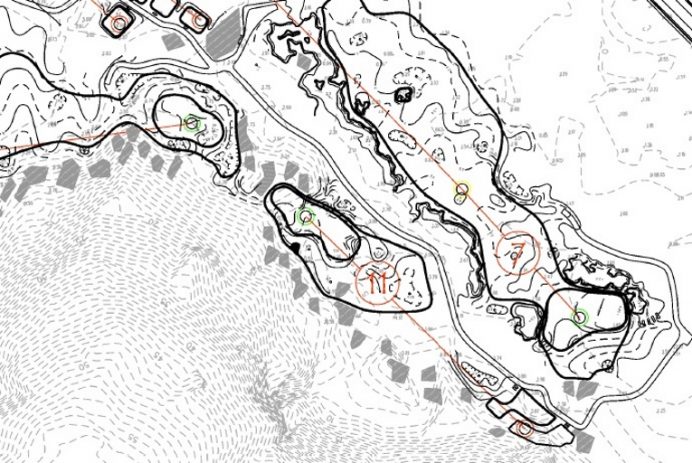
Holes 7 and 11 and Lang Co.
Regarding the 11th hole, it did not reveal itself immediately. That section of the property was thick jungle, almost impenetrable to walk through but the mountainside did offer us clues as to what we might find. As you enter the site there was an abundance of large boulders dotted about the slope and my hope was that the other side of the mountain would be the same. Once we found a large rock structure that now backs onto the current 12th tee, we felt that if we cleared a little bit more towards the mountain we might possibly find more and that’s what we did and we got lucky. The 11th and 6th greens are both framed by these spectacular boulders. As we cleared more of the slope on 11, we found more rock so we just kept clearing. We had to manufacture a tee complex but this worked out well and now there is a wonderful route from 10 green to 11 tee through these rock outcrops. We decided to build a long narrow green 50m (150 foot) in depth and maybe 12 – 15m in width to take advantage of the rocks down the entire left side and some of the right side. The back third of the green is nestled in the rocks.
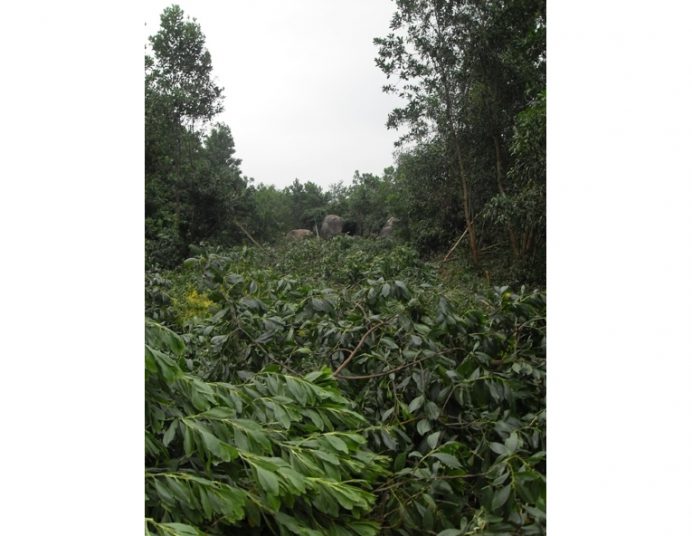
From this …
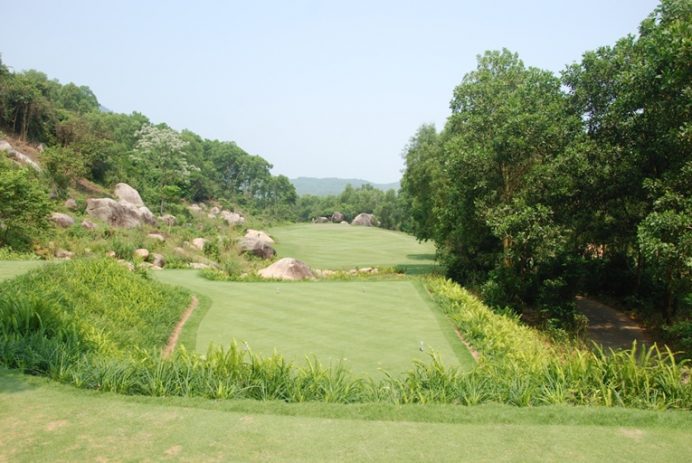
… to this! The 11th hole at Laguna Lang Co.
There was obviously no need to build any man-made features which would’ve taken attention away from the wonderful natural features. I haven’t been back to Lang Co since 2017 but by all accounts the Golf Director Adam Calver has done a wonderful job maintaining and improving the course.
7. After Faldo Design, then what?
Ultimately, I started my own business in Geneva in 2011 but was contracted to complete some projects with the Faldo group like Lang Co which opened in 2013.
My family moved to Canada a few years ago but my work has continued in Asia and the developing world given the relationships I built mostly through my work with Faldo. This means that a high percentage of my time is still spent in Asia. When I travel to a project, I spend considerable time on site as it would not be feasible to travel back and forth every few weeks. On some projects, the work necessitates that I base myself in the country for a good portion of the project term with my team. When I return to see the family, all I do is rest and spend time with my kids in Toronto, Canada.
Initially when I went out by myself, a primary business goal was to establish myself in the developing world where I could express a lot of my ideas and where I felt the best opportunities existed moving forward. I had also worked or traveled to many of these far flung destinations and was relatively well connected. It’s difficult enough to establish yourself in one state or country, so it has taken a lot of energy, time and money to establish myself in a number of countries.
I am now in a much better position, a bit older also, and am presently focused on spending more time at home in North America since my kids are growing up and I want to be a part of that.
8. You once wrote, ‘As a business sector, I don’t believe we have done ourselves any favours by designing, building and then putting the spotlight on golf courses that are excessive in every way.’
This was a section from an essay I wrote for the R&A golf course management sector a few years back. I have also discussed this subject at length at seminars around the globe with the R&A Head of Sustainability Steve Isaac, Agronomist Micah Woods and with Sam Thomas and Jonathan Smith of the Golf Environment Organization.
Many of the golf courses we read about and watch on TV are not the best examples of responsible design, construction and maintenance, which in turn creates a negative perception on the game. People outside of golf, looking for an opportunity to denigrate our game, use the way these golf courses look to highlight the amount of resources these facilities consume over a large area in support of their view that golf courses are a burden on the environment.
9. What are some egregious examples of waste and excess that you come across?
- Over irrigated areas
- Over spec’d irrigation systems
- Sand capping
- Over engineered bunkers with high tech lining
- To much input to achieve green
- To much emphasis on bunkers as the defining strategic element
- Building U.S.G.A. spec greens when not necessary
- Too much emphasis on subsurface drainage and not enough emphasis on surface drainage
- Too much emphasis on form over function
- Excessive amount of highly intensive maintained areas on a golf course outside of the main play areas (tees, fairways and greens). I can’t stress this point enough.
- Constant turnover/need to update maintenance equipment
10. Discuss the work being done at the Shangri La Hambantota golf course on the southern tip of Sri Lanka.
When I first visited Shangri La Hambantota in 2017, I was encouraged by the work the team were doing to become more environmentally sustainable. When the golf course was first built, the rough areas were all maintained paspalum grass requiring a substantial amount of water and people input at a real cost. Instead of continuing down this expensive path, the team at Hambantota decided to plant out some of the rough areas with pineapple (I believe pineapple is the national fruit of Sri Lanka and is certainly grown at mass in that part of the country).
This might sound absurd but instead of spending lots of money maintaining a space that sees limited play, they are now spending less money to maintain that space while simultaneously adding productivity to the land with the potential to generate money. From a golf purist’s perspective, the pineapple groves give the golf course more sense of place and the resort can also market itself – accurately – as being environmentally conscious.

Pineapples at Hambantota
The edible crop concept is something that I embrace in my work. When we built Laguna Lang Co, we regenerated nearly 4ha of rice crop field which now borders several of the holes. Golfers experience some of Vietnam whilst playing golf in Vietnam! Again, a strong sense of place manifests itself. Additionally, the rice crop generates food which is used at the resort and by the local communities. Everyone wins, as there are social, economical and environmental benefits.

A rice paddy at Laguna Lang Co.
11. What does ‘less is more’ mean to you? What is an example?
Golf holes or golf courses don’t need to have an excessive amount of features to make them good. When a golf hole or golf course is flooded with man-made features, this more often than not complicates the play area and lessens the opportunity to focus the golfer’s attention on existing features that in all likelihood would have improved the strategic interest and overall experience.
I’ve also sometimes used this term in conversations with clubs where I work. I tell them that spending copious amounts of money won’t necessarily equate to good. In fact, some of my favorite clubs excel because they don’t have lots of money to spend. There are a lot of examples but I will use two that come to mind that are not my own:
Yay Tagon Taung Golf Club, a 27 hole complex about an hours drive outside of Mandalay, Myanmar, is situated among some wonderful natural treescape and framed by mountains dotted with waterfalls and pagodas. Thankfully the play areas were not ruined with an abundant amount of features which gives golfers much more opportunity to appreciate the surrounds.
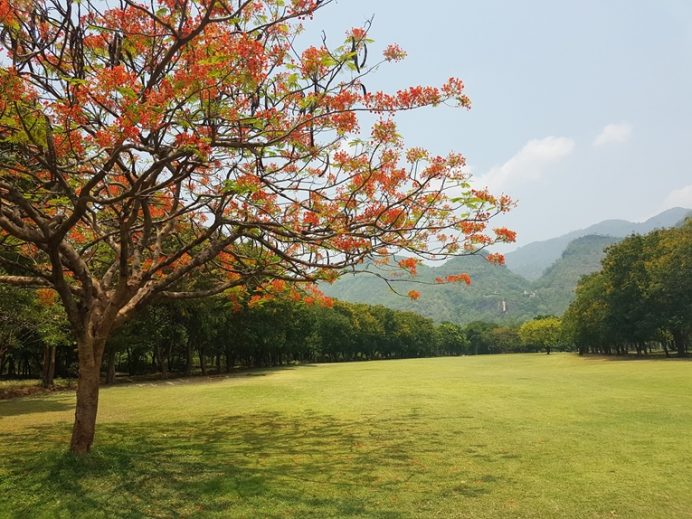
Yay Tagon Taung, Myanmar.
The same can be said for the Kabaku Komatipoort Golf Club, a nine hole golf course built by the local community of Komatipoort and located within a chip and putt of the Mozambique / South African border. The course is well routed to take advantage of wonderful on-site and off-site influences. Thankfully, that team was also not tempted to go overboard with building man-made features. The result is that golfers is free to experience an intensely African experience.
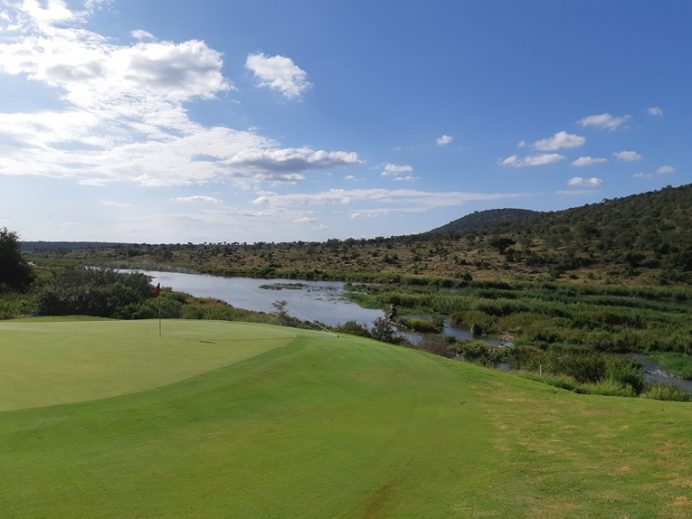
Kabaku Komatipoort with view out over Kruger National Park.
Feature Interview with Paul Jansen, pg. ii
12. Monsoons and high humidity plague Asian golf. Do some of the new grass strains improve playability and allow you to offer viable ground game options?
My motto, and it’s been successful so far, is to use the grass type that grows locally in that part of the world. Before I start any design work, I explore the region (not just the site) which often gives me design inspiration but it also allows me to study what grasses grow and survive in the climate with limited input. That’s the key.
I’ve seen cases where a foreign grass species has been introduced into a tropical environment at a high cost with disastrous effect. The new species invariably require more input and are more labor intensive than the native grasses. Importantly, the native grasses are generally easier to maintain and harder to kill, so if you make mistakes, it won’t be catastrophic. This is less so with non-native.
These new grass species generally require more water, which can necessitate a new irrigation system (at least where it is a renovation). Once you start throwing more water on the play areas, the native grasses start to reintroduce themselves or where they are confined to the rough areas compete more aggressively with the non-native. More labour is required to manage this work. You get the picture and sometimes it is a bleak, never ending, costly battle.
The best way to do things is to work with what grows locally and make that the best it can be.
13. What are some of your preferred, local grassing schemes in Asia?
I am a fan of local grasses that require minimal input. In South East Asia, this includes Manilagrass which I’ve used on projects in Vietnam, Thailand and Indonesia. I also believe Tropical Carpetgrass (also known as buffalograss) is another grass species that grows well in that part of the globe and other areas in Asia where it’s hot and humid and where they get a lot of rainfall. I recently used it in Sri Lanka and it worked out well.
The one real benefit from a playability perspective is that the zoysia grass is relatively drought tolerant and given the right conditions can produce fast playing conditions. It’s much harder to achieve this using Carpetgrass, for instance since this grass has a thick leaf and can get sticky like Kikuyu grass. It’s possible to achieve fast on other non-native grasses but this means more stress on the grass or more input.
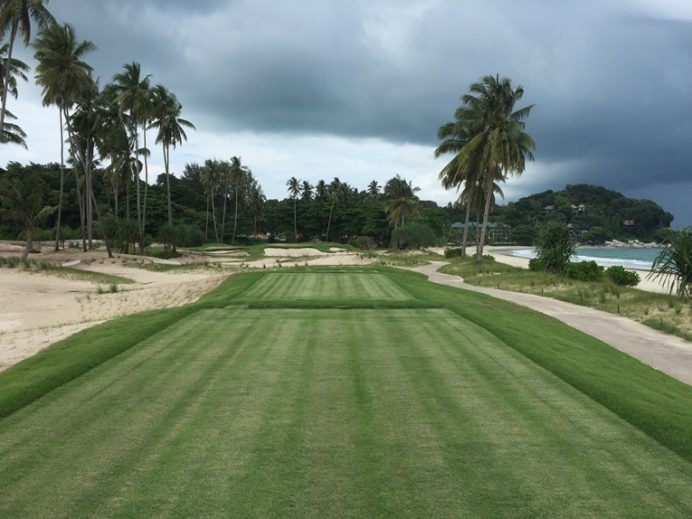
Manilagrass in Indonesia.
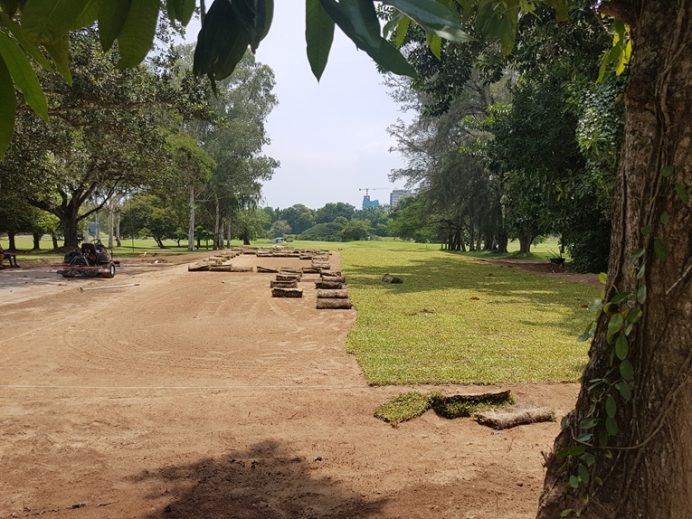
Tropical Carpetgrass in Colombo.
14. When and how did you start working with Mark Lawson from Australia? With whom else do you like working?
Mark and I first met in Vietnam on the Laguna Lang Co project in 2008. Australians, New Zealanders and South Africans are relatively similar so it was easy to work with him from the get go. He was the construction manager on the contractor side of that project and then he worked on projects with me directly in Thailand and Indonesia. He has also helped me from a far with other projects, most notably in Sri Lanka. Mark is one of those guys that can do everything from start to finish, is reliable, easy to work with and quickly adapts to any situation. Most importantly, he is just a great guy to be around.
I also have a Nepalese guy who works with me on select projects in the sub-continent. I can leave him on his own and know that he can do the job properly. I am currently working on a project in Japan and Keith Cutten is helping me out on the ground. He is another one who is really good at his craft and can manage a work site by himself. He has a very promising future.
15. What projects are you all working on now?
I have two projects currently on the ground. One in Japan at the Keya GC, outside of Fukuoka, where we are reworking the bunkers to begin.

The bunker project at Keya GC in Japan.
The other is a new 18 hole golf course in Coxs Bazar, Bangladesh. I am working with the Bangladesh Golf Federation, R&A, local stakeholders and the army to create the first 18 hole designed public course in that country.
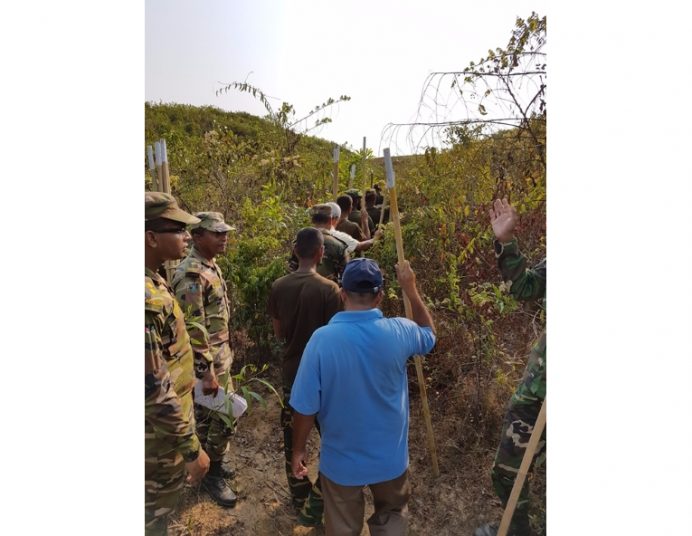
Off they head to route holes at Cox Bazar in Bangladesh.
Recently, I completed design work for a new 9 hole course in Romania and new 18 hole golf course in Sri Lanka. Add to that I am working with friend and golfer Shiv Kapur on the design for a par 3 nine hole golf course in India. I also consult at a number of clubs around the globe.
Having said that, my main focus these past 8 – 12 months has been helping short game golf guru Dave Pelz and his son Eddie develop Pelz Player Greens (www.pelzplayergreens.com) and also developing the short game and practice service side of my business. It’s been a wonderful experience for me to spend time with Dave, possibly the world’s best short game golf coach, and understand the dynamics and intricacies of short game practice. Both Dave and I believe that practice areas are an afterthought at most golf clubs and we both see this as an opportunity to improve that side of the business.
Everyone on this forum believes that golf courses need to be fun and similarly Dave sees the need for practice to be fun. It’s hard to motivate yourself and get better when a practice area is dull and uninspiring (this applies to golf courses too). Dave wants the golfer to be creative, use his/her imagination and be motivated to hit an extraordinary shot and not dictated to try only one type shot.
The idea is to recreate as many shots as you would find out on the golf course and more. If you look at his backyard for example, his design is not constrained by any rules other than the fact that bunker shot is away from the house. Every pin location asks interesting questions and calls for imaginative play whether it’s feeding your ball off a mound 15 feet from the pin or over a tree to the same location.
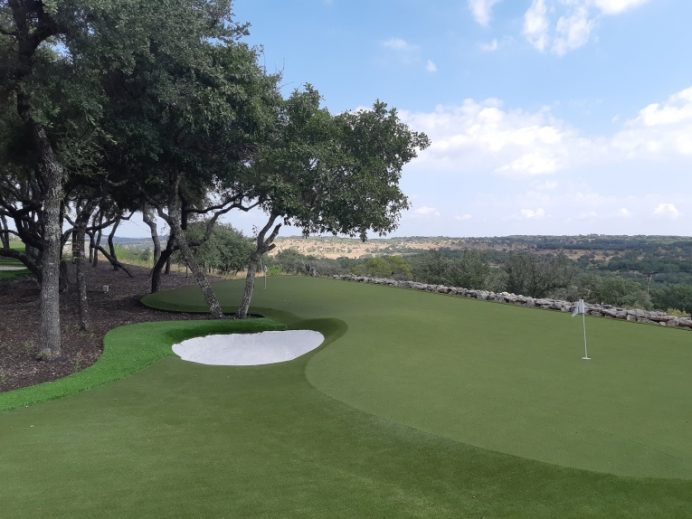
Dave Pelz’s backyard
Within a 2 acre space you are able to play upwards of 70% of the shots you would find on a standard 150 acre golf course. That’s a great use of space.

Paul Jansen, flanked by Dave and Eddie Pelz.
16. Tell us the genesis of this list www.jansengolfdesign.com/blog/top-100-golf-courses-you-may-never-have-heard-of-but-must-visit ?
That’s a great question. Some of it was born out of frustration of seeing the same lists of golf courses time and time again. As a business, we tend to glamorize a few hundred golf courses, which then typically get labeled the ‘best.’ I thought it would be a wonderful exercise to highlight some of the other fun, unique and distinctive golf courses out there. These are the golf courses that most inspire me and my work. I wanted to show people that there is more to golf than just playing the ‘best’ as defined by the media.
I’ve visited 74 of the golf courses on that list and am motivated to see all of them. Lorne Rubenstein once told me that every golf course has a story to tell and there is truth in that.
17. Asia encompasses a gigantic swath of land, large enough to hold 48 (!) countries. Which three countries hold the greatest potential for golf and why?
- China because of its size, both geographically as well as population wise.
- Russia because there is limited golf to date and it’s a big place.
- The Philippines because of its magnificent coastline and we know that golf and beach work well together.
18. Talk to us about the ‘Seven Wonders of Southern Asia.’
A few years ago I blocked out some time in my diary to visit the most sustainable and unique golf courses throughout Southern Asia. There was a lot of planning involved and admittedly some of the route was dictated by golf clubs at which I was interviewing. The goal of this adventure was threefold:
- Use the trip as an opportunity to highlight the richness and diverse nature of the golf experiences in Asia. Asia gets a bad rap sometimes which I think is unfair because some of the world’s most unique and fun courses can be found on the continent.
- Continue my own education, particularly where it related to sustainability. I made a point to visit the most environmentally and socially sustainable golf courses in the region.
- Promote the benefits of sustainable practice.
When I was done putting together the itinerary, it included nearly 40 golf clubs in 7 countries over something like 39 days. In discussion with friends they felt I should label the trip the Seven Wonders of Southern Asia. The route was as follows: Sri Lanka – India – Bangladesh – Indonesia – Myanmar – Vietnam – Cambodia. It was a highly successful trip with no serious mishaps and at the conclusion, I wrote a number of magazine articles detailing some of my findings.
The R&A also covered sections of the trip on their website. I tried to use social media as best I could as I moved through the countries which was difficult at times given the length of the days and amount of travel involved. One of the positive outcomes was a sustainable seminar series with the R&A and GEO talking about responsible design, construction and maintenance practice. We spoke to large audiences in Thailand, China, Japan, Korea and India.
I’ve been fortunate to partake in a number of epic trips over the years whether it be in GB&I, Continental Europe, Asia, Africa and to a lesser extend North America but the Seven Wonders tour covered more unique and sustainable golf courses. Plus, it featured the most places that people have never heard of!
19. Most of us can’t relate to playing past 17 pagodas (built 900 – 1200AD). How was the golf at Bagan in Myanmar?!
“Golf at its best is a perpetual adventure” – Bernard Darwin
An adventure is the answer. I knew travelling around Myanmar would be an adventure and I enjoy golf the most when the course promotes a sense of adventure and there was lots of that at Bagan.
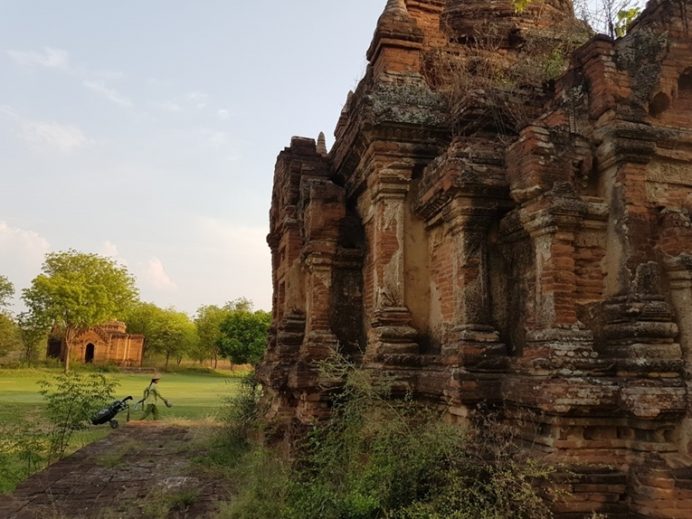
Bagan GC, Myanmar.
20. What are several other unique golf experiences that you have enjoyed via your travels?
There are an abundance in the United Kingdom and Ireland so I won’t get into too much detail for that part of the globe but I will say that Royal West Norfolk (Brancaster) is probably my favorite on the island. It’s unique in so many ways including the walk from the clubhouse to the 1st tee via the beach. My friend Nick Edmund wrote a majestic piece for Links Magazine detailing the course and is a must read. He also wrote about it in his Following the Fairways series. It was Nick that told me to visit.
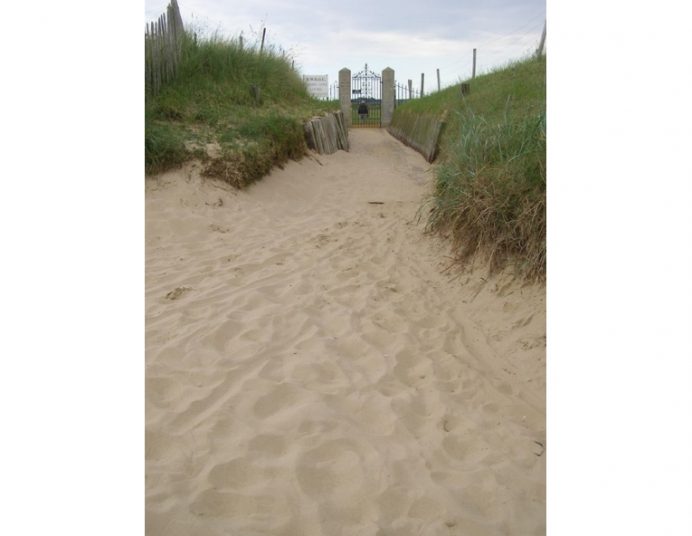
Brancaster from the beach
As a rule of thumb, the early golf courses built in the territories by the British are unique provided that they still occupy their original location and that the club has not spent money trying to rid the course of its quirkiness. Examples include Nuwara Eliya GC , Hong Kong GC Old and Thayet GC . There are others like the Bangalore GC which has been modernized but is still quirky including have a hole that plays over the car park.
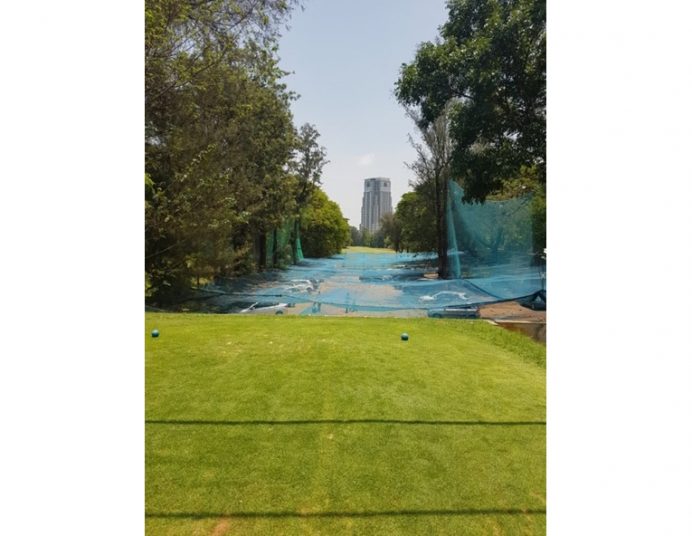
Over the car park we play at Bangalore GC!
Africa: The Skukuza Golf Club is a nine hole golf courses situated in the Kruger National Park that shares its space with abundant wildlife including hippos, crocodiles, water hogs and others. There have been lion and leopard sightings at dusk or dawn. Before you start the round, you sign an indemnity form stating that you are responsible for your own actions and well being on the course. All the “bushveld” golf courses of Southern Africa offer something unique with other examples including Sabi River, Hans Marensky, Elements, Zebula, Sishen, Sun City, Leopard Creek and Komatipoort.
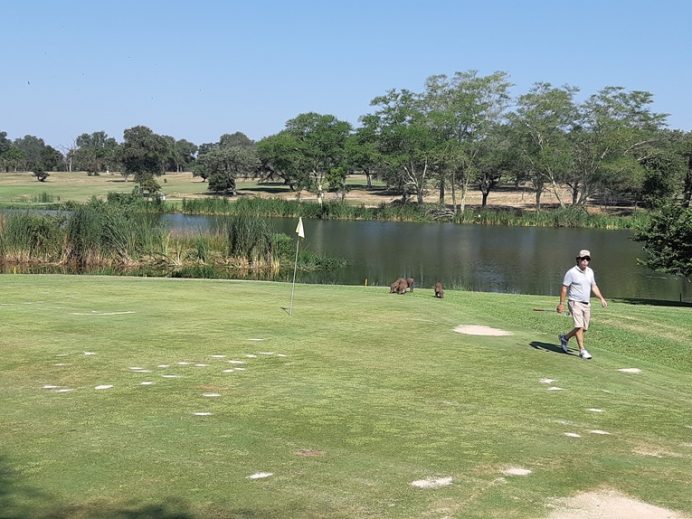
The 9th hole at Skukuza GC in South Africa, complete with hippos and crocodile in the water and waterhogs on the green.
Asia: I will select the Himalayan Golf Club. I visited with some of the Nepalese guys that worked with me in Bangladesh and Sri Lanka. That was an enjoyable day and an incredible place. Bring your hiking boots and enjoy the scenery including the Annapurna Massif, at over 8,000m, that frames the course.
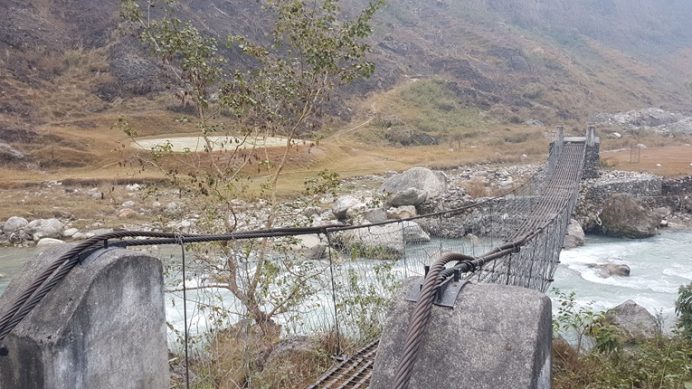
Crossing a rushing river at Himalayan GC.
Continental Europe: I have toured a lot of golf throughout Europe and particularly in the Benelux countries but for me the most unique course I’ve visited is in Scandinavia called Royal Copenhagen GC (RCGC). Superintendent extraordinaire Martin Nillson manages the course which is located on 800ha of land owned by the royal family but with public access. The property is fenced because of the 2,700 deer roaming the property and golf course. It’s a multi-use facility so people are cycling, running, walking, riding horses etc in between the golf. The best examples of sustainable golf, in my opinion, can be found in Scandinavia and RCGC is one such example. The golf course is pesticide free due to its location in one of the country’s most highly protected landscapes, they maintain 22ha and I believe there is only 6 green staff in total.
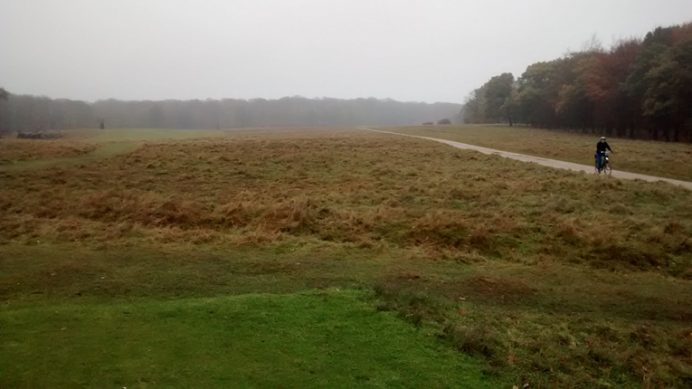
Royal Copenhagen.
I’m fortunate to consult at a few quirky clubs around the globe and the one phrase I use frequently when talking to committees and members is from Tom Simpson’s The Architectural Side of Golf where it reads “Roads, railways, sheds and gardens may be thought unsatisfactory and unwelcome, yet they are often the essence of a course; take them away and the difference would at once be felt”. There is much truth in that!

The railway line at Royal Colombo GC.
21. Sustainability is crucial to you. What are some examples of imbuing a course with features that, to paraphrase Colt, will stand the test of time?
This is a big topic but I will name a few areas we can do much better as a business.
I’ve written a lot about the benefit of ground contours over time. They are easy and cost effective to build and maintain, add immense strategic interest and help with drainage. I only truly understood the benefit of ground contours after studying the links of Scotland, England, Wales and Ireland from 2000 – 2005 and intermittently during my time with Faldo.
Multi-use golf courses: Golf courses cover such large expanses of land yet generally speaking, a high percentage of the overall area sees limited play. These limited play areas are still maintained at a high cost and this presents an opportunity to change for good. A lot of the work I do with golf clubs is to focus on reducing the human footprint or where there is a human footprint, make it productive. As with everything, it is place and country specific but a few good examples of multi-use include the Royal Bangkok Sports Club, Royal Copenhagen GC or a golf course like Sabi River Sun where nature and golf co-exist. Making golf more multi-use also helps improve the perception that golf is exclusive and closed walls.
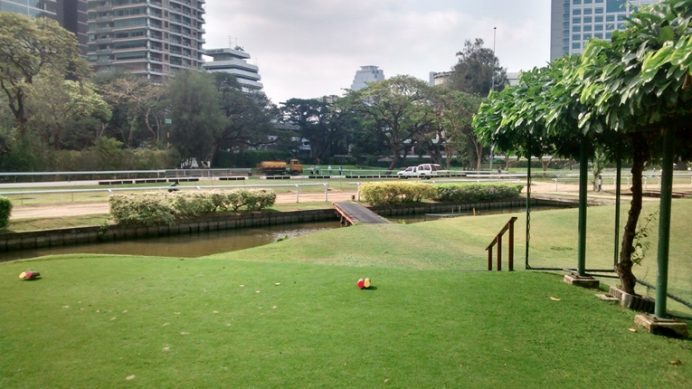
Bangkok Sports Club
On this note, I am a huge advocate for regenerative design. Instead of maintaining a space or leaving it fallow, generate some productivity from that space similar to what was done at Laguna Lang Co.
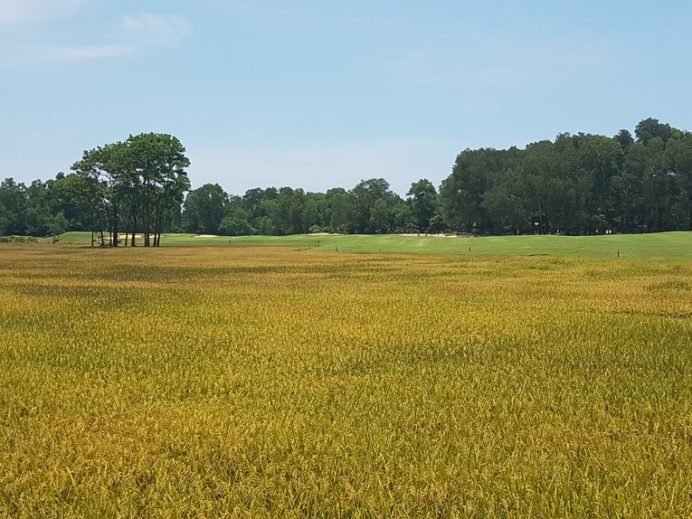
Rice paddy crops at Laguna Lang Co.
There is a great opportunity to recycle, particularly where it pertains to tree removal. Tree removal is a hot topic at many golf clubs and in my experience, making a case for recycling that tree or stand of trees helps build a case. On many of my projects, I have had a local carpenter recycle trees into everything from benches, signage, steps, bridge platforms and dustbins.
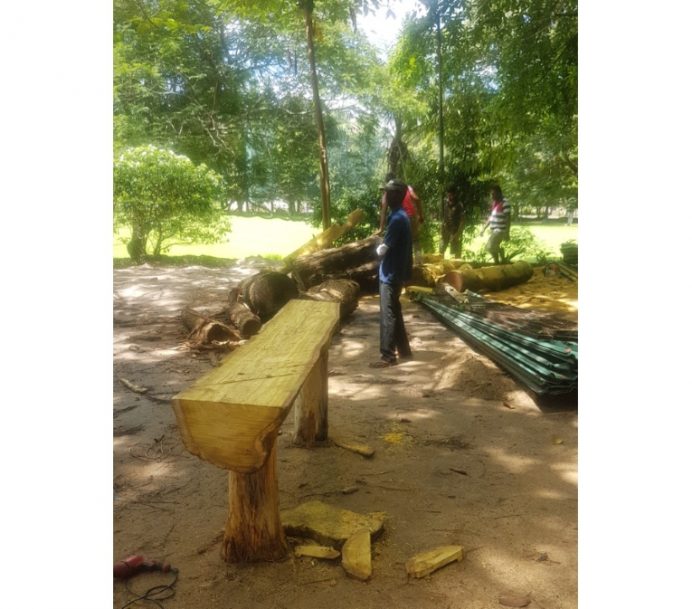
Recycling trees Sri Lanka.
At Laguna Phuket, we were able to recycle all the trees we removed during the rebuild into wood chips which were then spread into the rough areas that was previously maintained grass.
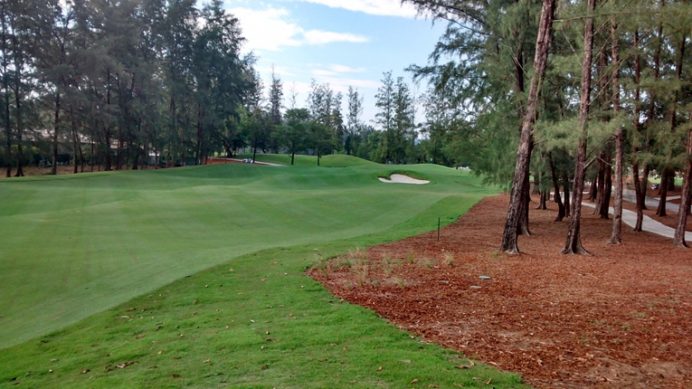
Recycled wood chips at Laguna Phuket are both attractive and low maintenance.
I also believe that there will be more demand for artificial turf at least for tee, green and short game areas as the game moves forward. I wouldn’t advocate artificial for the entire area, that would be unsustainable but I can see the benefit at high maintenance areas that require lots of input, manpower and that see lots of wear and tear.
22. Why should someone hire Jansen Golf Design & Construction?
Our main focus is working with clients that are interested in getting better from an environmental perspective and having them profit from this. We are primarily a course design firm but a lot of our work focus is outside of the play corridors looking at how we can improve such areas and make them more sustainable. If a client is looking at the entire course holistically, then we could be a good fit.
I bring a multitude of international experiences with me having worked on golf projects both big and small on continents around the globe.
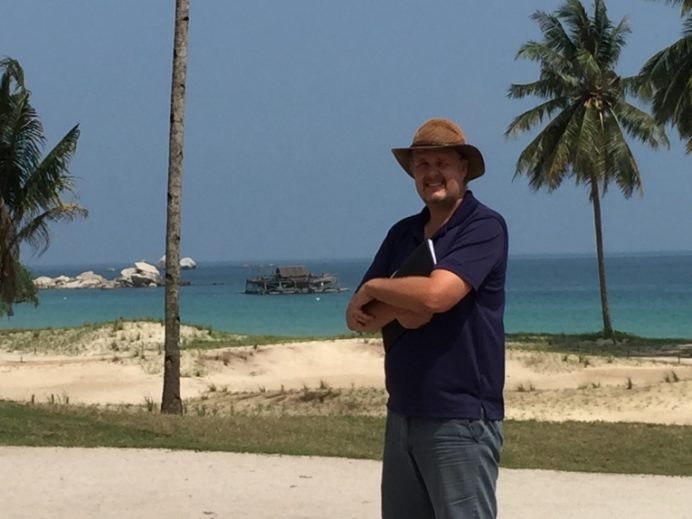
Paul Jansen on site in Indonesia.
More niche but still golf related, we assist and support any client who dreams of having a synthetic turf facility in their backyard or at their golf course. Our work with Pelz Player Greens Team and affiliates enables us to work extensively throughout North America and other parts of the globe.








